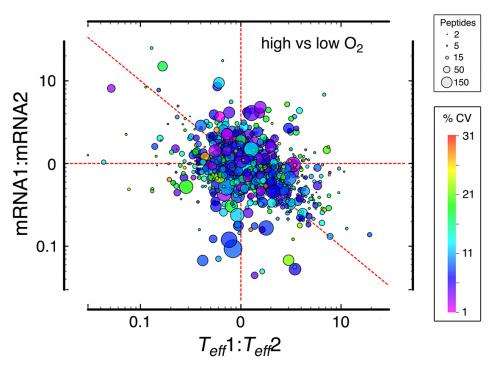Lost in translation: Gene expression changes don't always alter protein levels

(Phys.org) —The central dogma of biology is that DNA gives rise to mRNA, which then gives rise to protein. Thus, it has been widely assumed that changes in specific mRNA levels are always accompanied by commensurate changes in the encoded proteins and vice versa. To determine whether this is always the case, scientists at Pacific Northwest National Laboratory examined Shewanella oneidensis MR-1 grown under steady state conditions at either 20% or 8.5% O2.
Using a combination of quantitative proteomics and a next-generation sequencing technology, RNA-Seq, they generated high-confidence data on >1000 mRNA and protein pairs. Surprisingly, they found that changes in the expression of proteins in response to altered oxygen levels were caused primarily by differences in the translational efficiency of the mRNAs rather than changes in the mRNA levels.
For example, when oxygen levels were lowered, 28% of the detected proteins showed at least a twofold change in expression. Altered transcription levels appeared responsible for 26% of the protein changes, altered translational efficiency appeared responsible for 46%, and a combination of both were responsible for the remaining 28%.
Interestingly, changes in translational efficiency were significantly correlated with the pattern of codons in genes that encode different amino acids. Because measurable tRNA pools, which read the codons, also changed in response to altered O2 levels, this suggests that changes in the translational efficiency of genes are caused, in part, by alterations in the abundance of molecules that decode the mRNAs.
"To understand how microbes work together in communities, it's important to understand the functional state of their member species," said Dr. Steven Wiley, PNNL Laboratory Fellow, who led the work, which was published in Integrative Biology. "Metagenomics analyses have provided important data on the functional potential of each community species, but their actual functions are highly dependent on their pattern of protein expression, which, in turn, is modulated by the local microenvironment of each cell."
How cells change the expression of proteins in response to their environment is one of biology's most fundamental questions. Theoretically, changes in the synthesis of specific mRNAs can give rise to altered protein levels, but the multitude of steps between transcription and translation provide many different regulatory opportunities. Advances in high-throughput sequencing technologies and mass spectrometry now allow scientists to look globally at the multiple steps that control protein expression levels. These approaches provide the potential for understanding larger, systems-level regulatory mechanisms that can provide insight into fundamental biological design principles.
The relationship between protein and mRNA levels was determined by using a steady state mathematical model to analyze Shewanella grown under steady state conditions. The levels of mRNA were determined by RNA-Seq, and quantitative global proteomics measurements were made using the accurate mass tag, or AMT, approach developed at PNNL. By using numerous biological and technical replicates, a very high-quality and precise data set was obtained, affording analysis of the relationship between more than 1000 mRNA-protein pairs.
This work highlights the need to include proteomics measurements in the analysis of microbial systems. The integrated and quantitative approach developed here for identifying the level at which proteins are regulated provides a foundation for more detailed mechanistic studies to understand how cells control protein expression and for explorations of why translational efficiency changes under different cell environments.
More information: Taylor, R. et al. 2013. Steady State Analysis of Integrated Proteomics and Transcriptomics Data Shows Changes in Translational Efficiency a Dominant Regulatory Mechanism in the Environmental Response of Bacteria, Integrative Biology 5(11):1393-1406. DOI: 10.1039/c3ib40120k.
Journal information: Integrative Biology
Provided by Pacific Northwest National Laboratory


















